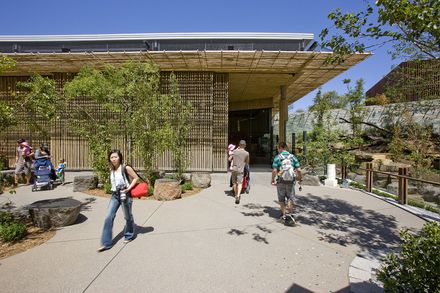
Adelaide Zoo Giant Panda Forest
ARCHITECTS
Hassell
LOCATION
Adelaide SA, Australia
CLIENT
Zoos SA
MAIN CONTRACTOR
Hindmarsh
PROJECT YEAR
2009
PHOTOGRAPHS
Peter Bennetts
PROJECT TEAM
Sharon Mackay, Timothy Horton, Nicholas Persons, Alex Hall, Ed Mitchell, Andrew Schunke, John Wright, Josh Palmer, Amy Reed, Hugh Fraser, Maciek Furmanik, Mariano DeDuonni, Sam Wee, Meaghan Williams, David Bills, Yi Kai Lim
Text description provided by architect.
The Adelaide Zoo Giant Panda Forest, designed by HASSELL, is one of the world’s leading exhibits for the iconic and endangered giant panda species.
The design of the Panda Forest embodies the Zoo’s core principles of environment, education, conservation and research and redefines the concept of a zoo in the 21st century – as a contemporary conservation organisation with vital breeding and research programs.
In 2007, Adelaide Zoo was entrusted with the care of two giant pandas – Wang Wang and Funi – for a period of 10 years.
Soon after, HASSELL was honoured to be chosen to design their new home – the first in the southern hemisphere and only the eighth exhibit in the world.
Early in the design process HASSELL toured four of the seven existing exhibits with the Adelaide Zoo team and tested the brief against world’s best practice.
Understanding the behavioural characteristics of the giant pandas was critical to designing an immersive environment that allows the animals to behave as they would in the wild.
The resulting architecture and landscape responds to the pandas’ native Chinese heritage within an Australian context. A series of ‘pavilions’ in the landscape frame a changing relationship between the public and the giant pandas, providing alternating views of landscape, animal behaviour and habitat.
The new exhibit is integrated with the existing pathway network of the Zoo, providing an accessible and attractive journey through the enclosure and implicitly reinforcing conservation messages. Seating, shade trees and pavilions provide opportunities to contemplate the environment and conservation information.
The 3,000 square metre exhibit balances the need to provide the pandas with choices, comfort and stimuli while providing management flexibility for keepers and excellent viewing access for visitors. A multi-species exhibit, the enclosure houses the male and female giant panda as well as up to three pairs of red pandas and mandarin ducks.
The pandas have access to two 600 square metre outdoor exhibits as well as air-conditioned day rooms. The holding building sets new standards for the management of giant pandas and provides the keepers with flexibility and control.
The holding building houses a research facility for 24-hour Closed Circuit Television (CCTV) and observation.
A range of design features have been used to enrich the environment, particularly focusing on climate control. Chilled rocks, streams and waterfalls for bathing, mature shade trees for climbing, and glass reinforced concrete caves for shade and shelter create a comfortable and stimulating environment for the animals.
A central glazed axis provides public views of research, food preparation and holding facilities. The sheltered public viewing terrace incorporates a giant underslung bamboo canopy and large sliding screens to accommodate crowds and manage privacy.
Collaboration and wide consultation was vital to the success of the exhibit. The Zoo’s specialist keepers, vets, visitor experience and interpretation experts collaborated to develop functional requirements for the exhibit in the absence of formal standards for this type of facility.
As well as the wildlife conservation objectives, the Zoo also aspired to demonstrate environmentally sustainable outcomes within the built environment.
Solar orientation was an imperative factor in site planning to maximise the opportunities for the giant pandas to use the external exhibits. The exhibit incorporates several sustainable practices including green roofs and appropriate material selection.
The day room floor consists of ‘deep litter’ mulch – an innovative composting technique that removes the need for wash down and wasteful water use.
Dayrooms are double glazed, and ‘close down’ to the east and west to reduce heat load. ‘Block work’ and concrete construction provide thermal mass to maintain temperature control.
The resilient exhibit can be retro fitted to accommodate other bear species and is designed to be flexible to accommodate improvements in animal husbandry, refurbishing of the landscape and the changing needs of the Zoo.
A Chinese government delegation who recently visited the Giant Panda Forest described the exhibit as “the world’s leading exhibit” for these iconic and endangered animals.


















